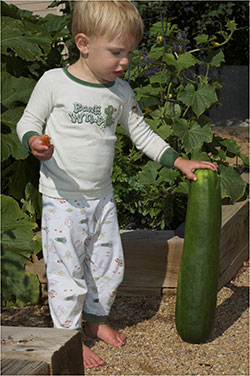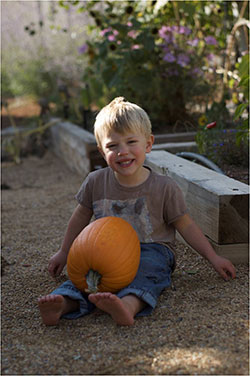Erika Strote
Colorado State University Extension Master Gardener in Larimer County
May 9, 2015

Kids are natural-born gardeners. They are more than willing to get wet and dirty, their fingers are just the right size for poking holes in the soil to plant seeds, and they delight in the magic of watching a plant grow into food they can harvest and eat. It doesn’t take much to nurture this childhood excitement. So what is holding you back?
No space?
Even a few parsley seeds in a cup of potting soil on your windowsill can capture the attention of your child. If you keep the soil evenly moist, you will see the seeds start to sprout in a few days. Once your seedlings are large enough, you can transplant them outdoors or add a garnish to dinner.
If you have a sunny spot outside, plant a container or two with vegetables and herbs. It doesn’t need to be a fancy pot—just about any container can be used as long as it has a drainage hole and hasn’t previously held toxic materials since you will be growing plants to eat. Use a good quality potting soil and check your pots often to make sure they don’t dry out. In the heat of the summer this can mean watering once or twice a day—a great job for your young gardener. Fertilizing on a regular basis will ensure that your container plants get the proper nutrients for a successful harvest. But don’t be surprised if your yields are not as high as you think they will be. I’m willing to bet a large portion of the harvest will go directly from plant to mouth!
Many edible plants can be grown in containers. If you have space for a one-gallon container, you can try some herbs and radishes. A three-gallon container is ideal for carrots and lettuce, and a container that is at least 5 gallons will allow for tomatoes, peppers or beans to flourish.
Your kid doesn’t like vegetables?

One friend was astonished to see her vegetable-adverse son harvesting radishes from our garden and devouring them alongside my children. Growing and harvesting their own vegetables encourages kids to try different foods.
Let your children help you select seeds or plants that appeal to them. Involve them in the planting process and, if space is available, consider giving them their own pot or corner of the garden. Remember the “wow” factor: kids delight in yanking out a plant and discovering a bright radish or crisp carrot has been growing under the soil. Plants in different colors such as purple beans or cherry tomatoes in shades of yellow and orange will also amuse young gardeners.
When should you plant?
All plants for the vegetable garden can be divided roughly into two categories: cool season crops and warm season crops. Cool season crops go in the ground earlier in the spring when the nights are still cool and occasionally frosty. These are plants like snap peas, lettuces, radishes, carrots and beets. Warm season crops go in the ground after the risk of frost has diminished. These are plants like tomatoes, beans, cucumbers, summer squash and pumpkins.
In Fort Collins, there is only a minimal chance of the temperatures dropping below 32 degrees after May 16, so you should be safe planting your warm season crops after this date (though yield may be better if you wait until Memorial Day). You will often be able to find both cool and warm season plants for sale in the early spring, but beware of putting out the warm season crops too early—one hard frost can turn your beautiful basil plant to mush and a few days of cool daytime weather can stunt your tomato crop.
While you are waiting for your plants to grow large enough to harvest, check out gardening books from the library. One great book for young children is Growing Vegetable Soup by Lois Ehlert. A hilarious read for older children is Tops and Bottoms by Janet Stevens, a Colorado author. And, finally, anyone who has rabbits in their yard will appreciate Muncha! Muncha! Muncha! by Candace Fleming.
For more information visit cmg.extension.colostate.edu, click on Online Yard and Garden Publications and read the following:
Information about container gardening:
- Extension Fact Sheet #7.238: Container Gardens
- CMG GardenNotes #724: Vegetable Gardening in Containers
You can check the average last frost date for your area:
And some information and tips about growing vegetables can be found at:
- CMG GardenNotes #720: Planting Guide – Vegetable Planting Guide
- CMG GardenNotes #719: Vegetable Garden Tips
- Extension Fact Sheet #7.611: Fertilizing the Vegetable Garden
The author, Erika Strote, submitted the photos of her son in the garden (now age 8 ½) and of her puppy (now age 11).
The author has received training through Colorado State University Extension’s Master Gardener program and is a Master Gardener volunteer for Larimer County.
——————-
Larimer County is a county-based outreach of Colorado State University Extension providing information you can trust to deal with current issues in agriculture, horticulture, nutrition and food safety, 4-H, small acreage, money management and parenting. For more information about CSU Extension in Larimer County, call (970) 498-6000 or visit www.larimer.org/ext
——————-
Looking for additional gardening information? Check out the CSU Extension Horticulture Agent blog at www.csuhort.blogspot.com for timely updates about gardening around the state.
——————-
Visit PlantTalk Colorado ™ for fast answers to your gardening questions! www.planttalk.org PlantTalk is a cooperation between Colorado State University Extension, GreenCo and Denver Botanic Gardens.





